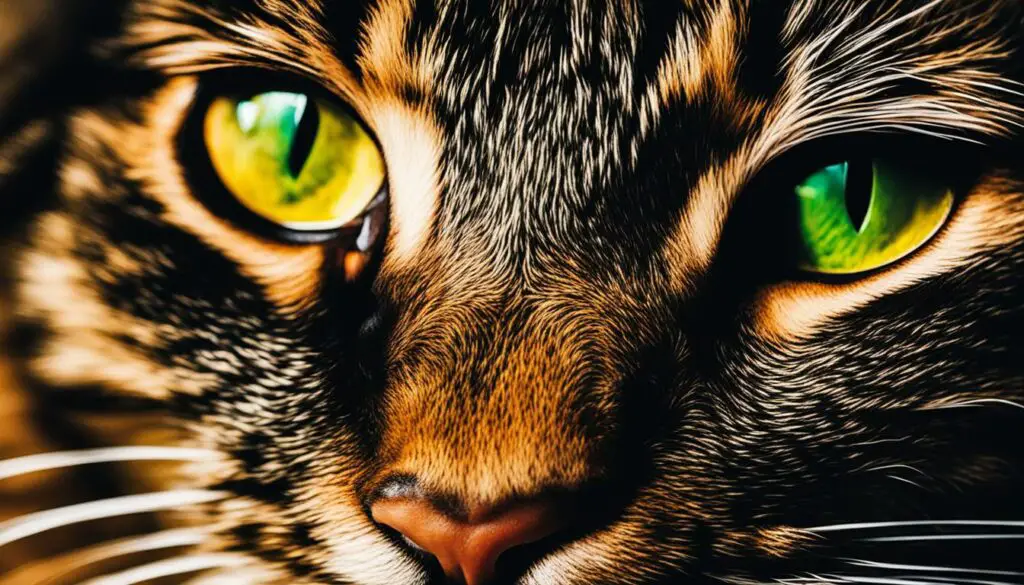Have you ever wondered why some cats have eyes that go in opposite directions? It’s a fascinating phenomenon known as strabismus, and it’s more common than you might think. In this article, I will delve into the details of this intriguing feline behavior and explore the reasons behind cats’ eyes going in opposite directions.
Key Takeaways:
- Strabismus is a common condition in cats where their eyes are out of alignment.
- Sudden development of strabismus in adult cats may indicate an underlying health issue.
- Strabismus can be congenital in certain breeds or develop due to other conditions.
- Signs of strabismus may include cross-eyed appearance, rapid eye movement, and other accompanying symptoms.
- Diagnosis of strabismus involves physical and ophthalmic exams, and treatment options vary depending on the underlying cause.
What Is Strabismus in Cats?
Strabismus is an eye condition in which the eyes are not aligned with each other. It occurs when the muscles that control eye movement are too short or too long, or if there is damage to the nerves or brain that coordinates eye muscle movement. Cats with strabismus may have difficulty focusing and judging depth. While it is not a cause of blindness, sudden onset of strabismus in adult cats may indicate underlying health issues.
Causes of Strabismus in Cats
Strabismus in cats can have various causes. Some cats are born with the condition, inheriting it from their parents. This is common in breeds like Siamese cats, Himalayan cats, and Persians. Additionally, strabismus can develop in adult cats due to factors such as infections (viral, bacterial, fungal), trauma, nerve damage, stroke, cancer, hydrocephalus, or inner ear disease. When strabismus develops suddenly in an adult cat, it often indicates an underlying condition that requires veterinary attention.
Signs of Strabismus in Cats
The most obvious sign of strabismus in cats is their cross-eyed appearance. While cats born with strabismus adjust well to their condition and live normal lives, sudden onset of strabismus in adult cats may be accompanied by additional signs such as rapid eye movement, different pupil sizes, droopy eyelid, bulging eye, head tilt, circling or falling to one side, seizures, weakness, loss of appetite, vomiting, and fever. These signs may indicate a more serious underlying condition that requires immediate veterinary attention.
Diagnosing Strabismus in Cats
To diagnose strabismus in cats, a veterinarian will perform a physical and ophthalmic exam. This includes testing eye movement, light reflex, eye pressure, and other eye tests. They may also conduct a neurological examination to check for any underlying conditions. Additional tests such as bloodwork, viral testing, imaging studies, or referral to a specialist may be required to determine the cause of strabismus.
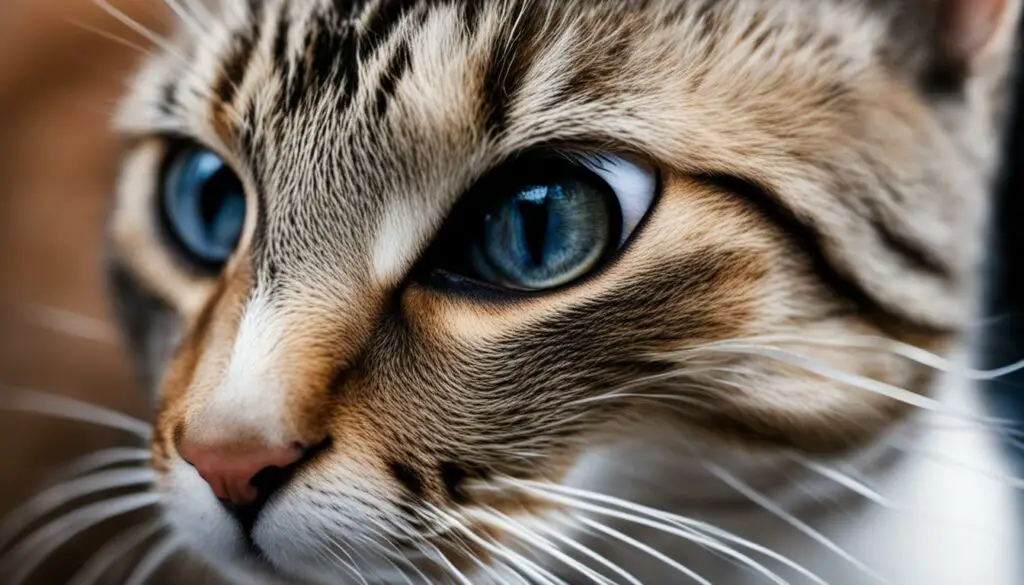
How Common Is Strabismus in Cats?
Strabismus, also known as crossed eyes, is a relatively common condition in cats. While it can occur in any breed, certain breeds like Siamese cats are more prone to developing strabismus. In these breeds, strabismus is often present from birth and is considered a congenital condition. Congenital strabismus can manifest as either convergent (pulling the eyeball towards the nose) or divergent (pulling the eye towards the side of the face).
However, strabismus can also develop in cats due to other factors. In some cases, trauma, infections, nerve damage, strokes, cancer, hydrocephalus, or inner ear diseases can affect the coordination of eye muscles, leading to strabismus. Additionally, as cats age, they may develop strabismus as a result of certain health issues. Therefore, while strabismus is commonly seen in certain breeds, it can occur in cats of any breed or age.
Prevalence of Strabismus in Cats by Breed
| Breed | Prevalence of Strabismus |
|---|---|
| Siamese | High |
| Himalayan | High |
| Persian | High |
| Other Breeds | Variable |
Note: The prevalence of strabismus in other cat breeds may vary.
If you notice that your cat has crossed eyes, it is essential to consult with a veterinarian for a proper diagnosis. While strabismus itself may not cause significant problems for your cat, it can sometimes be an indication of an underlying health issue that requires attention.
What Causes Strabismus in Cats?
Strabismus, also known as crossed eyes, can occur in cats due to various factors. Some cats are born with the condition, inheriting it from their parents, which is common in breeds like Siamese cats, Himalayan cats, and Persians. This is known as congenital strabismus. On the other hand, strabismus can develop in adult cats due to different underlying causes.
One possible cause of strabismus in cats is infections, including viral, bacterial, and fungal infections. These infections can affect the nerves and muscles that control eye movement, leading to misalignment. Trauma, such as injuries to the head or face, can also result in strabismus. Damage to the nerves or brain that coordinate eye muscle movement can cause the eyes to be out of alignment as well.
Additionally, certain health conditions can contribute to the development of strabismus in cats. These include stroke, cancer, hydrocephalus (fluid buildup in the brain), and inner ear disease. If a cat suddenly develops strabismus as an adult, it is essential to seek veterinary attention as it could indicate an underlying condition that requires treatment.
Table: Common Causes of Strabismus in Cats
| Cause | Description |
|---|---|
| Congenital | Inherited from parents, common in certain breeds like Siamese, Himalayan, and Persians |
| Infections | Viral, bacterial, or fungal infections affecting eye muscle coordination |
| Trauma | Injuries to the head or face causing damage to eye muscles or nerves |
| Neurological Conditions | Stroke, cancer, hydrocephalus (fluid buildup in the brain), or inner ear disease affecting eye muscle coordination |
Identifying the underlying cause of strabismus in a cat is crucial for determining the appropriate treatment. Therefore, it is important to consult with a veterinarian if your cat shows signs of strabismus or experiences a sudden onset of crossed eyes.
What Are the Signs of Strabismus in Cats?
Cats with strabismus, or misaligned eyes, exhibit certain signs that can help identify the condition. The most obvious sign is the cross-eyed appearance, where the eyes point in different directions. This can occur from birth (congenital) or develop later in life (acquired). When strabismus occurs suddenly in adult cats, it may indicate an underlying health issue that requires immediate veterinary attention.
In addition to the cross-eyed appearance, cats with strabismus may exhibit other signs such as rapid eye movement, different pupil sizes, droopy eyelid, bulging eye, head tilt, circling or falling to one side, seizures, weakness, loss of appetite, vomiting, and fever. These signs can indicate a more serious underlying condition that needs to be addressed.
It is important to note that cats born with strabismus typically adapt well to their condition and lead normal lives. However, sudden onset of strabismus in adult cats should not be ignored, as it may be a warning sign of an underlying health problem.
“The most obvious sign of strabismus in cats is their cross-eyed appearance. Cats born with strabismus typically adjust well to their condition and live normal lives.”
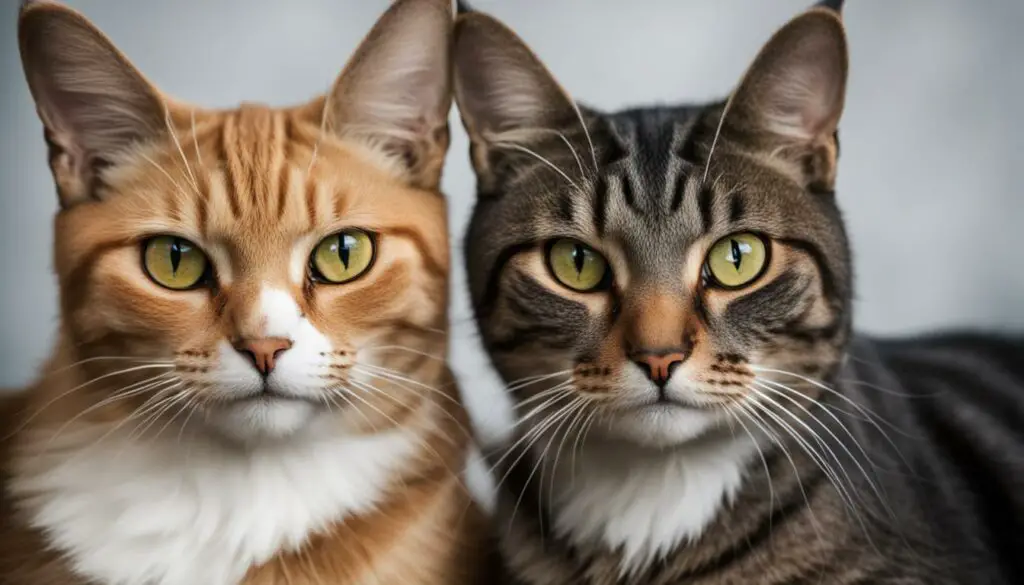
| Signs of Strabismus in Cats | Description |
|---|---|
| Cross-eyed appearance | Eyes pointing in different directions |
| Rapid eye movement | Eyes moving quickly and involuntarily |
| Different pupil sizes | One pupil larger than the other |
| Droopy eyelid | One eyelid lower than the other |
| Bulging eye | Eye protruding more than usual |
| Head tilt | Head tilted to one side |
| Circling or falling to one side | Loss of balance and coordination |
| Seizures | Involuntary muscle contractions |
| Weakness | Lack of strength or vitality |
| Loss of appetite | Decreased interest in food |
| Vomiting | Expelling of stomach contents |
| Fever | Elevated body temperature |
How Is Strabismus in Cats Diagnosed?
Diagnosing strabismus in cats involves a comprehensive physical and ophthalmic examination performed by a veterinarian. During the examination, the vet will assess the cat’s eye movement, light reflex, eye pressure, and other relevant factors. These tests help determine if the cat’s eyes are properly aligned and functioning. Additionally, a neurological examination may be conducted to rule out any underlying conditions that may be causing strabismus.
In some cases, additional tests such as bloodwork, viral testing, or imaging studies may be necessary to identify the specific cause of strabismus. These tests can provide valuable insights into the cat’s overall health and help guide the treatment plan. In more complex cases, the veterinarian may refer the cat to a specialist with expertise in feline ophthalmology.
Overall, the key to diagnosing strabismus in cats lies in thorough examination and evaluation of the cat’s eye function, neurological status, and relevant medical history. Through a comprehensive approach, veterinarians can accurately diagnose strabismus and determine the appropriate course of treatment.
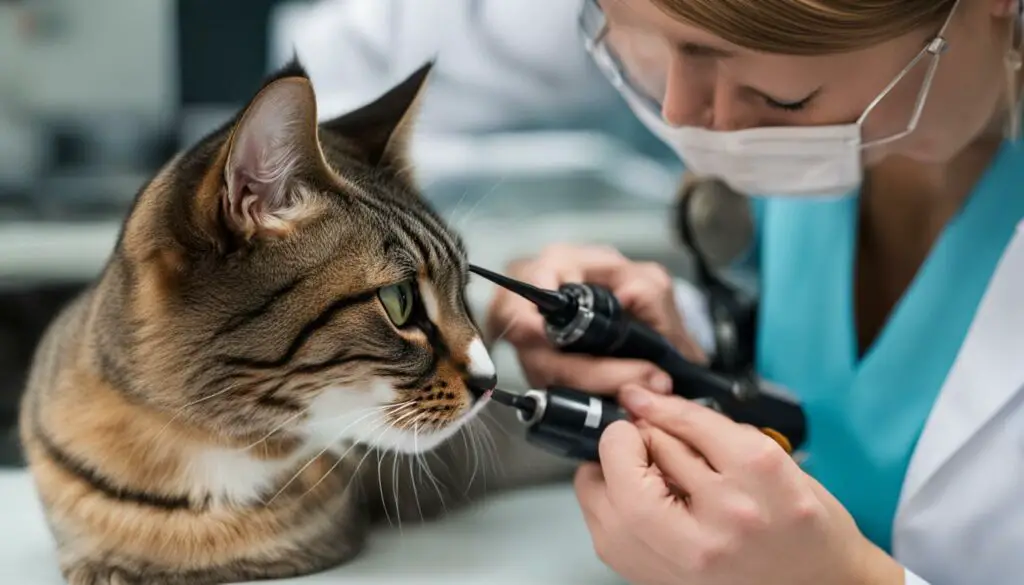
Eye Tests for Strabismus in Cats
There are several eye tests that veterinarians may use to diagnose strabismus in cats. These tests help assess the alignment and movement of the cat’s eyes, providing valuable information about the underlying condition. Some common eye tests for strabismus include:
- Hirschberg test: This test involves shining a light into the cat’s eyes and observing the position of the light reflection on the cornea. If the cat’s eyes are properly aligned, the light reflection will be centered. If there is strabismus, the light reflection will be off-center.
- Cover test: The cover test is performed by covering one of the cat’s eyes and observing the movement of the uncovered eye. If the uncovered eye moves to refocus, it indicates strabismus.
- Tracking test: This test involves moving an object in front of the cat’s eyes and observing how well the cat can track the object. If the eyes do not move together or if one eye lags behind, it suggests strabismus.
These eye tests, combined with the physical and ophthalmic examination, provide valuable information for the accurate diagnosis of strabismus in cats. Veterinary professionals use their expertise and specialized tools to perform these tests and ensure the best care for cats with strabismus.
Treating Strabismus in Cats: Options for Restoration
When it comes to treating strabismus in cats, there are several options available to restore normal alignment and improve their quality of life. The specific treatment approach will depend on the underlying cause of the strabismus. One common treatment method is strabismus surgery, which aims to correct the abnormal eye muscles that are causing the misalignment. Strabismus surgery in cats involves adjusting the length or strength of the affected muscles to bring the eyes back into proper alignment.
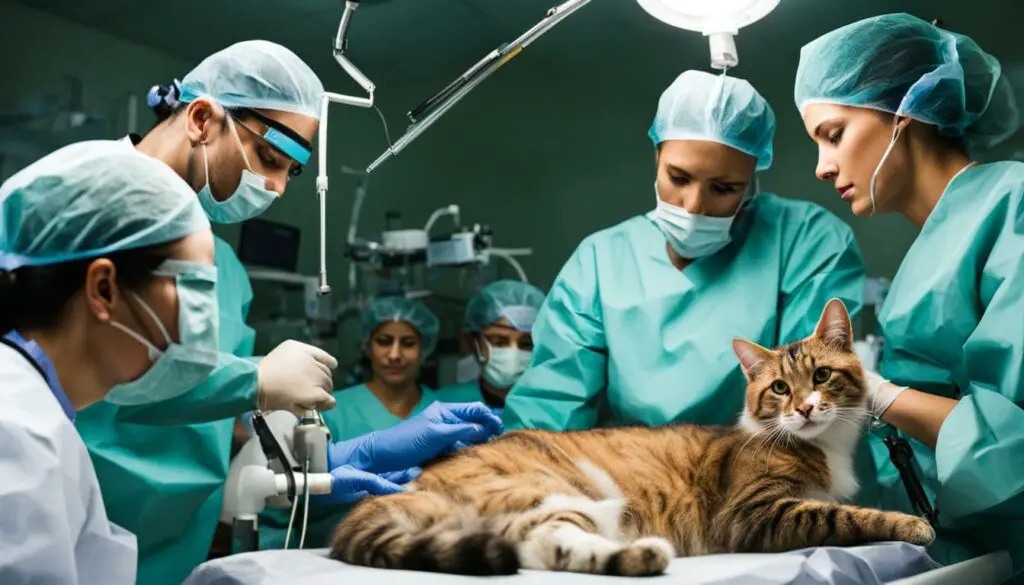
In cases where the strabismus is caused by a tumor, surgical removal of the tumor may be necessary, along with radiation therapy or chemotherapy to prevent its recurrence. Antibiotics may also be prescribed post-surgery to prevent infections and promote healing.
Physical Therapy for Strabismus in Cats
In addition to surgery, physical therapy can be an effective treatment option for cats with strabismus. Just like humans, cats can benefit from exercises that target the eye muscles and help improve coordination. Daily eye exercises, such as following a moving object or tracking a laser pointer, can strengthen the eye muscles and enhance their ability to work together.
Second Opinion and Holistic Options
If your cat has been diagnosed with strabismus and you’re unsure about the chosen treatment plan, seeking a second opinion from another veterinarian may provide additional insights and options. They may recommend alternative or holistic treatments, such as acupuncture or herbal remedies, that could help alleviate the symptoms or address any underlying causes of the strabismus.
Caring for a Cat Post-Treatment
After undergoing strabismus surgery or other treatments, it’s important to follow your veterinarian’s post-operative instructions and provide proper care for your cat’s recovery. This may include administering medications, keeping the surgical area clean, and monitoring for any signs of infection or complications.
By exploring the various treatment options available, consulting with your veterinarian, and providing the necessary care, you can help your cat regain normal eye alignment and live a happy, healthy life.
Understanding Agenesis and Other Eye Conditions
When it comes to unusual eye conditions in cats, agenesis is one that stands out. Agenesis refers to the incomplete formation of the eyelid, which can lead to wide-open eyes and discomfort for the cat. This condition can affect the cat’s ability to blink properly and protect their eyes from irritants. If your cat has agenesis, it is important to consult with a veterinarian for a proper diagnosis and to discuss possible treatment options.
In addition to agenesis, there are other eye conditions that can cause strabismus in cats. One of these conditions is feline leukemia virus (FeLV), which is a viral infection that can lead to various health issues, including eye problems. Meningitis, an inflammation of the protective membranes surrounding the brain and spinal cord, can also cause strabismus in cats. Lastly, hydrocephalus, a condition characterized by the buildup of fluid in the brain, can affect the normal functioning of the eyes and lead to strabismus.
Table: Common Eye Conditions in Cats
| Condition | Description |
|---|---|
| Agenesis | The incomplete formation of the eyelid, leading to wide-open eyes. |
| Feline Leukemia Virus (FeLV) | A viral infection that can cause various health issues, including eye problems. |
| Meningitis | Inflammation of the protective membranes surrounding the brain and spinal cord. |
| Hydrocephalus | Buildup of fluid in the brain, affecting normal eye functioning. |
It is crucial to consult with a veterinarian if your cat exhibits any unusual eye conditions, including agenesis or other eye abnormalities. A proper diagnosis can determine the underlying cause and guide appropriate treatment options. Remember, a veterinarian is the best resource for ensuring your cat’s health and well-being.
Surgical Correction for Strabismus in Cats
When it comes to treating strabismus in cats, surgical correction is one of the options available. This procedure is especially recommended if the abnormal eye muscles have been damaged due to trauma. The surgical correction involves correcting the lengths or strengths of the affected muscles to restore proper alignment of the eyes.
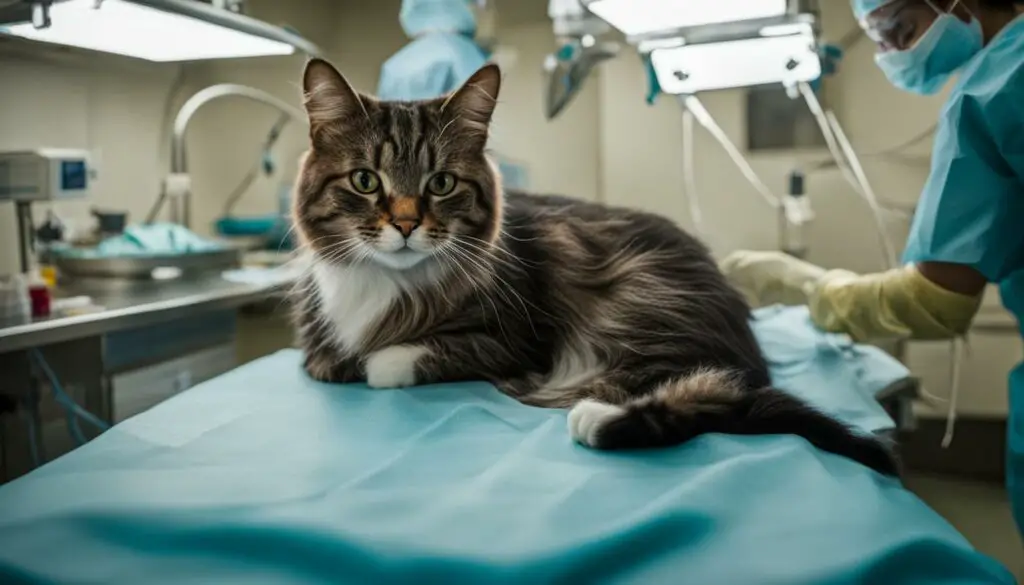
During the surgery, general anesthesia is administered to ensure the comfort and safety of the cat. Once the anesthesia takes effect, the veterinarian will make precise incisions to access the affected muscles. The muscles are then adjusted to achieve the desired alignment of the eyes. The incisions are carefully sutured, and appropriate post-operative care is provided to prevent any infections or complications.
Benefits of Surgical Correction
Surgical correction for strabismus in cats can have several benefits. It can help improve the cat’s vision by aligning the eyes correctly, resulting in better depth perception and focusing ability. Additionally, the surgery can enhance the cat’s overall quality of life by reducing any discomfort or vision-related issues caused by strabismus. It is important to consult with a veterinarian to determine if surgical correction is the right option for your cat and to ensure optimal outcomes.
In cases where the strabismus is caused by a tumor, the surgical removal of the tumor may be attempted along with radiation therapy or chemotherapy, if necessary. The specific treatment plan will depend on the underlying cause of the strabismus and the overall health of the cat. It is crucial to provide the necessary post-operative care, follow-up appointments, and any prescribed medications to aid in your cat’s recovery.
| Benefits of Surgical Correction for Strabismus in Cats | Risks and Considerations |
|---|---|
| Improves vision and depth perception | Potential risks associated with anesthesia |
| Enhances overall quality of life | Possible post-surgery complications |
| Reduces discomfort and vision-related issues | Requires careful post-operative care |
It is important to remember that surgical correction for strabismus in cats should only be performed by a qualified veterinarian who specializes in ophthalmic surgery. They will have the necessary skills and expertise to ensure the best possible outcome for your feline companion.
Antibiotics and Physical Therapy as Treatment Options
When it comes to treating strabismus in cats, there are several options available. Depending on the underlying cause of the condition, antibiotics and physical therapy can be effective treatment methods. Antibiotics are commonly prescribed in cases where bacterial infections or inner ear infections are affecting the vestibular system in the brain. These medications help alleviate the underlying causes of strabismus and aid in the cat’s recovery.
In addition to antibiotics, physical therapy can also play a crucial role in the treatment of strabismus in cats. Daily eye exercises and other physical therapy techniques can help strengthen the eye muscles and improve coordination. This can significantly improve the cat’s ability to focus and function properly.
It is important to note that the treatment approach will depend on the specific needs of each individual cat. Consulting with a veterinarian is essential to determine the most appropriate treatment plan for your furry friend. They will be able to assess the underlying cause of the strabismus and recommend the best course of action, which may include a combination of antibiotics, physical therapy, and other treatments if necessary.
Table: Comparison of Antibiotics and Physical Therapy for Strabismus in Cats
| Treatment Method | Benefits | Considerations |
|---|---|---|
| Antibiotics | – Effective in treating bacterial and inner ear infections – Helps alleviate underlying causes of strabismus – May prevent further complications |
– Requires proper diagnosis and prescription – Side effects and allergic reactions may occur – Long-term use may be necessary in some cases |
| Physical Therapy | – Strengthens eye muscles – Improves coordination and focus – Non-invasive and drug-free option |
– Requires consistent and dedicated effort – Results may vary depending on the severity of the strabismus – May need professional guidance and supervision |
It is important to follow all post-surgery instructions and provide proper care to aid in your cat’s recovery. Regular check-ups with the veterinarian will help monitor progress and make any necessary adjustments to the treatment plan. With the right combination of antibiotics and physical therapy, many cats with strabismus can lead happy and fulfilling lives.

Cats Being Cross-Eyed: Googly-Eyes and Agenesis
Some cats have an endearing trait of having misaligned or “googly” eyes, which adds to their unique appearance. One possible cause for this condition is agenesis, where the eyelid doesn’t form correctly. This can result in wide-open eyes and potential discomfort for the cat. While many people find these cats adorable, it is essential to consult with a veterinarian to ensure their well-being and assess any underlying issues that may be causing the misalignment.
Googly eyes in cats can present themselves as a result of various factors, including conditions like feline leukemia, meningitis, and hydrocephalus. These conditions can lead to strabismus, which is the medical term for misaligned eyes. Identifying these underlying health issues is crucial for appropriate diagnosis and treatment. If your cat exhibits googly eyes or other eye abnormalities, consulting with a veterinarian will help determine the cause and provide the necessary care to ensure their health and well-being.
It is important to note that googly eyes in cats can be a result of abnormal muscle and nerve control over eye movement. While certain breeds may be more prone to hereditary strabismus, other factors like infections or muscle issues can also contribute to the condition. Working closely with a veterinarian will help to determine the underlying cause and explore suitable treatment options if necessary.

Throughout history, cats with googly eyes have captured the hearts of many individuals. Their unique appearance brings a sense of charm and fascination. However, it is crucial to ensure these cats receive proper care and attention to address any discomfort or underlying health issues they may be experiencing.
Googly-Eyed Cats and Science
When it comes to understanding the causes of googly eyes in cats, it’s important to delve into the fascinating realm of neural connections in their eyes. The intricate network of nerves and muscles that control eye movement can sometimes experience abnormalities, resulting in misaligned eyes. While hereditary factors can predispose certain breeds to strabismus, other underlying issues such as infections or muscle problems can also contribute to this condition.
The neural connections in cats’ eyes play a crucial role in coordinating the movement of their eyes. These connections are responsible for ensuring that both eyes move simultaneously and accurately, allowing cats to focus on objects and assess depth perception. However, when these connections are disrupted or damaged, the eyes can go in opposite directions, creating the googly-eyed appearance that many find endearing.
Understanding the neural connections in cats’ eyes can shed light on why some cats develop strabismus. This condition can occur due to abnormalities in the muscles that control eye movement or damage to the nerves that coordinate these movements. In some cases, infections or other health issues can impact these neural connections, leading to misalignment of the eyes.
While googly eyes may give cats a unique charm, it’s crucial to consult with a veterinarian if you notice this condition in your feline companion. By identifying the underlying causes of strabismus, veterinarians can recommend appropriate treatment options and ensure the overall well-being of your cat.
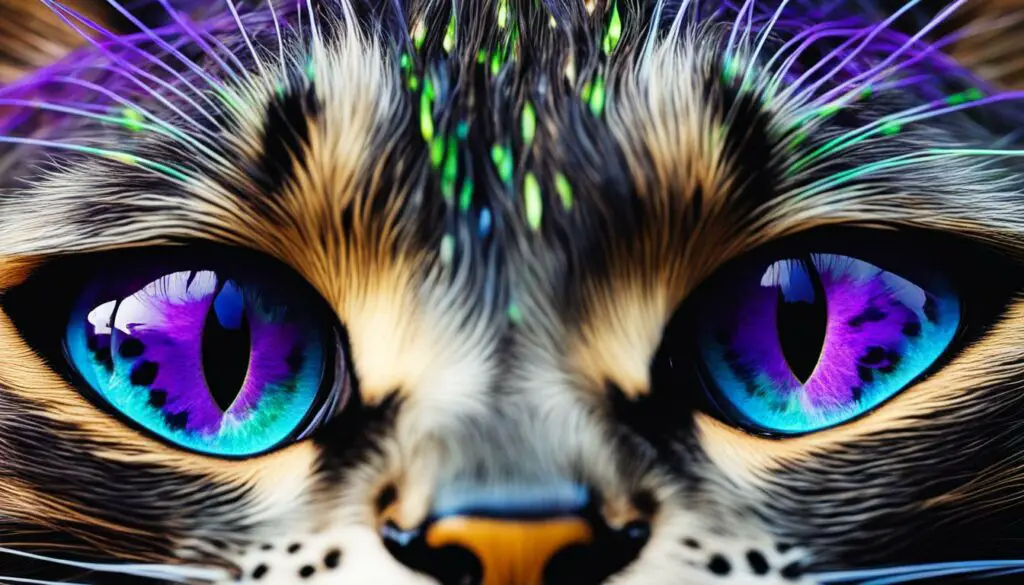
The Importance of Early Diagnosis
Early diagnosis of strabismus is crucial for cats, especially if the condition develops suddenly in adult cats. This is because it can indicate an underlying health issue that requires prompt veterinary attention. By seeking professional help early on, cat owners can ensure that their furry friends receive appropriate care and treatment to help manage the condition effectively. Regular check-ups and monitoring the health of your cat’s eyes can help catch any abnormalities before they progress.
Googly-Eyed Cats and Other Factors
Googly eyes in cats can be caused by various underlying conditions, including feline leukemia, meningitis, and hydrocephalus. These conditions can result in strabismus, where the eyes appear misaligned or cross-eyed. When a cat has googly eyes, it’s essential to consult with a veterinarian to determine the cause and appropriate treatment.
Feline leukemia is a viral infection that weakens the immune system and can lead to various health problems, including eye abnormalities. Cats with feline leukemia may develop strabismus as the virus affects the nerves and muscles responsible for eye movement. It’s important to have your cat tested for feline leukemia and discuss treatment options with your veterinarian.
Meningitis, an inflammation of the membranes surrounding the brain and spinal cord, can also contribute to googly eyes in cats. Meningitis can be caused by bacterial or viral infections and can lead to neurological complications, including strabismus. Prompt diagnosis and treatment are crucial to managing meningitis and minimizing its impact on your cat’s eye health.
Hydrocephalus, a condition characterized by an accumulation of fluid in the brain, can cause increased pressure and damage to the neurological system. Cats with hydrocephalus may exhibit various symptoms, including strabismus. Treatment for hydrocephalus typically involves managing the underlying cause and relieving pressure on the brain. Consult with your veterinarian to determine the best course of action for your cat.
| Condition | Cause | Treatment |
|---|---|---|
| Feline Leukemia | Viral infection weakening the immune system | Testing, management of symptoms, supportive care |
| Meningitis | Inflammation of membranes surrounding the brain and spinal cord | Diagnosis, medication, supportive care |
| Hydrocephalus | Accumulation of fluid in the brain | Management of underlying cause, pressure relief |
Remember, googly eyes in cats can be a sign of an underlying health issue, so it’s important to seek veterinary attention. A thorough examination and appropriate diagnostic tests will help determine the cause of the eye abnormalities and guide the best treatment plan for your furry friend.
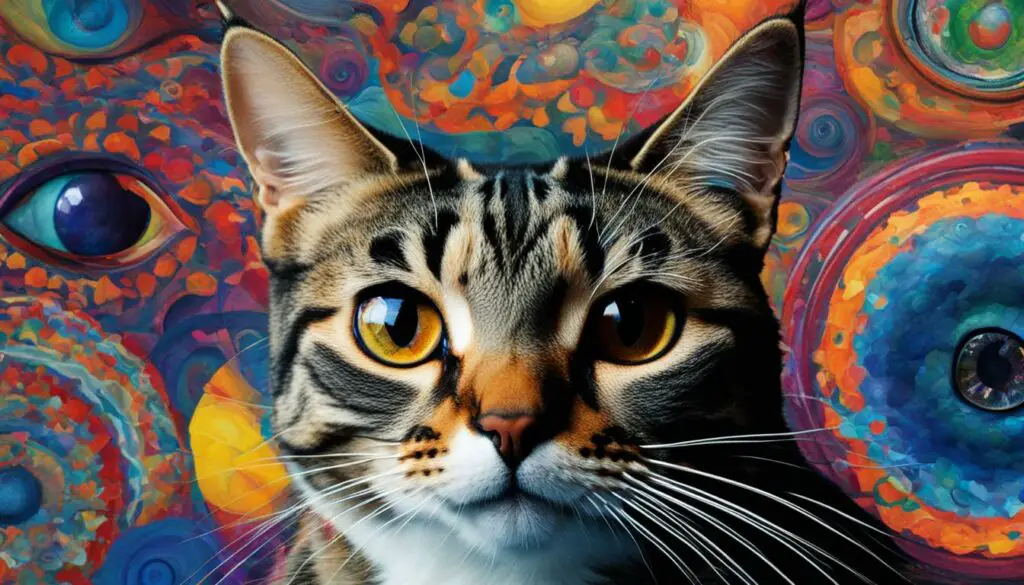
Conclusion: Understanding Why Cats Eyes Go in Opposite Directions
In conclusion, cats with strabismus, commonly known as googly eyes or crossed eyes, can lead normal lives and adapt well to their condition. However, it is crucial to pay attention to sudden onset strabismus in adult cats, as it may indicate an underlying health issue that requires veterinary attention.
Diagnosing strabismus involves a thorough physical and ophthalmic examination by a veterinarian. Additional tests may be required to determine the cause of the condition, such as bloodwork, viral testing, or imaging studies.
Treatment options for strabismus in cats vary depending on the underlying cause. While congenital strabismus may not require treatment, surgery, medication, or physical therapy may be necessary for cases related to infections, nerve damage, or tumors.
If your cat exhibits googly eyes or other eye abnormalities, it is essential to consult with a veterinarian to ensure their overall health and well-being. Remember, early detection and proper treatment can improve your cat’s quality of life and alleviate any discomfort they may be experiencing.
FAQ
What is strabismus in cats?
Strabismus is an eye condition in which the eyes are not aligned with each other, resulting in a cross-eyed appearance.
How common is strabismus in cats?
Strabismus is relatively common in certain breeds like Siamese cats, but it can also develop in cats due to other conditions that affect eye muscle coordination.
What causes strabismus in cats?
Strabismus in cats can be congenital, inherited from their parents in breeds like Siamese, Himalayan, and Persian cats. It can also develop in adult cats due to infections, trauma, nerve damage, stroke, cancer, hydrocephalus, or inner ear disease.
What are the signs of strabismus in cats?
The most obvious sign of strabismus in cats is their cross-eyed appearance. Cats with sudden onset of strabismus may also have rapid eye movements, different pupil sizes, droopy eyelids, bulging eyes, head tilt, circling or falling to one side, seizures, weakness, loss of appetite, vomiting, and fever.
How is strabismus in cats diagnosed?
A veterinarian will perform a physical and ophthalmic exam to diagnose strabismus in cats. This includes testing eye movement, light reflex, eye pressure, and other eye tests. Additional tests such as bloodwork, viral testing, imaging studies, or referral to a specialist may be required.
Is strabismus in cats treatable?
Treatment for strabismus in cats depends on the cause. Congenital strabismus that doesn’t affect a cat’s quality of life may not require treatment, but if strabismus is due to an underlying condition, appropriate treatment should be pursued. Surgery, medications, and physical therapy are common treatment options.
What is agenesis and other eye conditions in cats?
Agenesis is a condition where the eyelid doesn’t form correctly, leading to wide-open eyes and discomfort for the cat. Other eye conditions like feline leukemia virus, meningitis, and hydrocephalus can also cause strabismus in cats.
Is there a surgical correction for strabismus in cats?
Yes, surgery is often used to correct strabismus caused by abnormal eye muscles. General anesthesia is required for this procedure. In cases of tumor-related strabismus, surgical removal of the tumor may be attempted, along with radiation therapy and chemotherapy if necessary.
Are antibiotics and physical therapy used to treat strabismus in cats?
Antibiotics may be prescribed in cases where bacterial or inner ear infections are affecting the vestibular system in the brain. Physical therapy, including daily eye exercises, can be used to strengthen eye muscles and improve coordination.
What are googly-eyed cats and agenesis?
Googly-eyed cats are cats with misaligned eyes, often caused by strabismus. Agenesis is a condition where the eyelid doesn’t form correctly, leading to wide-open eyes and discomfort for the cat.
What are the causes of googly eyes in cats?
Googly eyes in cats can be caused by conditions like strabismus, agenesis, and other factors such as feline leukemia, meningitis, and hydrocephalus.
Are there any other factors related to googly-eyed cats?
Yes, conditions like feline leukemia, meningitis, and hydrocephalus can cause strabismus in cats. It is important to consult with a veterinarian for proper diagnosis and treatment options.
Source Links
- https://cats.com/strabismus-in-cats
- https://wagwalking.com/cat/condition/crossed-eyes
- https://www.thedodo.com/googly-eye-cats-dogs-1565321189.html

